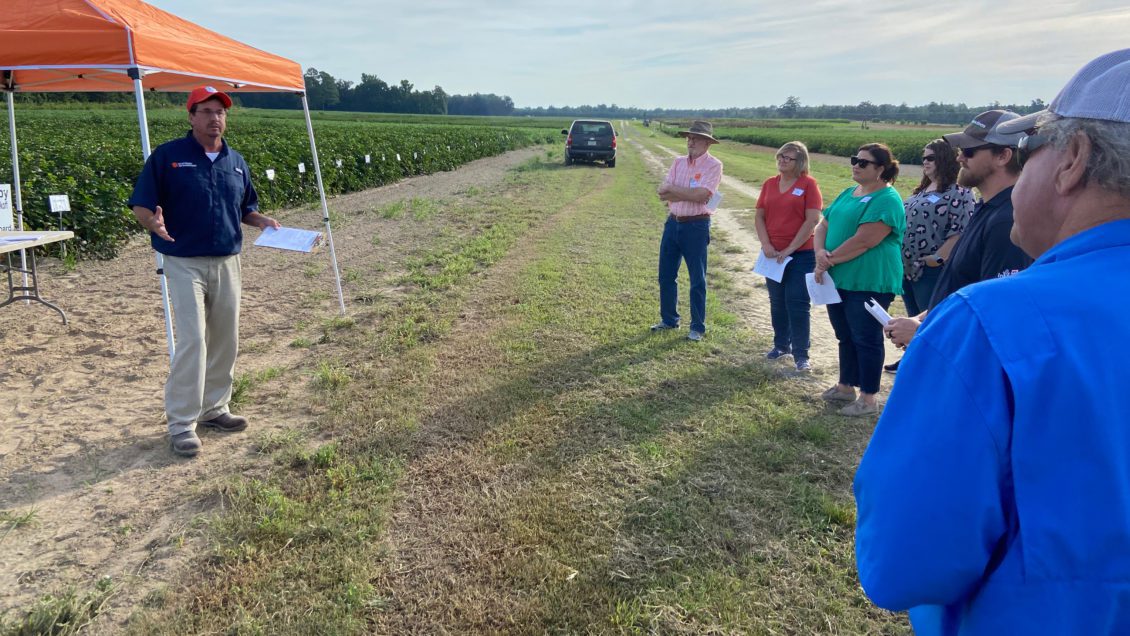
When it comes to variety selection, you have to do your homework. Study available data and temper it with your experiences to find varieties that will work best for you.
– Michael Jones, Clemson Extension cotton specialist
This year has been “great” for cotton and a Clemson Extension cotton specialist says variety selection is key for success.
During the 2022 Clemson Pee Dee Research and Education (REC) Field Day, Clemson Cooperative Extension Service Cotton Specialist and agronomy professor Michael Jones told producers variety selection is the most important decision they can make when planting cotton.
Jones continued by saying farmers should prioritize yield potential and stability when choosing what variety to plant.
“When it comes to variety selection, you have to do your homework,” Jones said. “Study available data and temper it with your experiences to find varieties that will work best for you.”
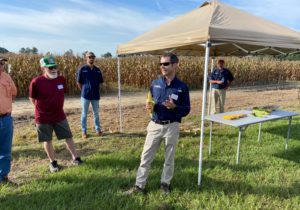
Jones reported a new Bt cotton variety, ThryvOn, is expected to be released in the United States in 2023. ThryvOn cotton contains the Bt trait, MON 88702, that targets thrips and tarnished plant bugs, mitigating damages and yield loss from these insects. Bt cotton is genetically altered by the insertion of a common soil bacterium, Bacillus thuringiensis, to produce certain proteins that are toxic to specific insects.
For 2022, Jones reported about 260,000 acres of cotton have been planted in the state, with a yield of about 900 pounds of lint per acre.
In addition to variety selection, field day attendees learned a main pest of cotton also is a pest of corn. Francis Reay-Jones, Clemson Extension entomologist and Integrated Pest Management (IPM) coordinator, said the corn earworm is known as the bollworm in cotton. Modern management of the insect primarily relies on using transgenic Bt technology in both corn and cotton. But corn earworms in the southeastern United States have developed resistance to several Bt toxins, primarily because of selection pressure in Bt corn, which is leading to increased problems later in the season in Bt cotton.
“Only Bt corn hybrids that include the Vip3A toxin have been found to provide excellent levels of control,” Reay-Jones said.
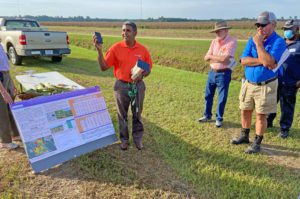
Corn growers are required to manage Bt resistance by planting non-Bt corn refuges. This strategy involves planting non-Bt corn within a Bt corn field or within half a mile of the Bt corn field to promote the survival of Bt susceptible individuals, which subsequently will mate and dilute potential resistance. This will help to preserve Bt technology in both corn and cotton. For more information, read “Corn earworm as a pest of field corn,” in the Clemson Extension Land-Grant Press.
Bhupinder Farmaha, Clemson nutrient management specialist, talked about “What rate of chicken litter to apply to maximize soybean yields” and “Is potash application really improving soybean yield?” Farmaha said researchers found over-fertilization of potassium can reduce soybean yields. He also talked about how using broiler litter as a fertilizer can have a positive impact on soil health and other functions. But, he also said the characteristics of broiler litter are variable and depend on litter quality and soil factors.
The field day also included a discussion about the Clemson IPM Program by Tim Bryant. Rongzhong Ye talked about cover crops and soil health and Ryan Bean discussed using prescribed fire and planting wildlife plots to manage forests. Wonkeun Park, senior scientist, discussed crop diversity and improvement, while J.C. Chong, Clemson Extension specialist, ended the tour with a discussion about new tomato breeding lines that are resistant to whiteflies and spider mites, and Jose Payero, Clemson Extension irrigation specialist, demonstrated using cloud-based soil moisture monitoring technology for irrigation scheduling.
Genetic diversity and cover crops
Sachin Rustgi, associate professor of molecular breeding, told participants about his projects involving breeding novel traits in cotton and peanuts. Rustgi is principal investigator for a Cotton Incorporated-supported study to improve Upland Cotton yields by altering the crop’s growth habit from a perennial crop to an annual crop.
Perennial crops regrow each year, while annual crops live for just one growing season and then die. In addition, perennial crops conserve assimilates (sugars) for regrowth in the next growing season, which is wasted as cotton is now treated as an annual crop. These assimilates could be channeled to produce more bolls. Regrowth after plant defoliation and dry downs also reduces harvest quality and negatively impacts revenue.
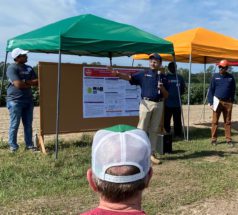
“Cotton has a worldwide economic impact of $500 billion,” Rustgi said. “But cotton yields have remained stagnant over the years. Through this study, we aim to break down the genetic code and identify molecular markers associated with flowering and other growth traits in Upland Cotton to develop a ‘truly’ annual variety. This will enhance productivity without adding to input costs.”
Other researchers involved are Michael Jones, Clemson Extension cotton specialist, and Todd Campbell of the United States Department of Agriculture Agricultural Research Service (USDA-ARS).
Genetic diversity in cotton is important as it allows for improvements in fiber quality and yield stability. In an update on the Pee Dee Cotton Breeding Program, Campbell said 18 advanced breeding lines were evaluated in three locations across South Carolina and North Carolina in a project funded by the South Carolina Cotton Board. Yields were strong and a number of breeding lines equaled high value Pima cotton for fiber quality.
“Growers need a variety that can stand up to changing environmental conditions and still perform well,” Campbell said.
Eric Billman, research agronomist with the USDA-ARS talked about using perennial cover crops to minimize cotton inputs and Binaya Parajuli, Clemson graduate research assistant in the Plant and Environmental Sciences Department, talked about using cover crops to reduce nitrogen losses in row crops.
Pathogens, pollinators, plant breeding, blueberries and butterbeans
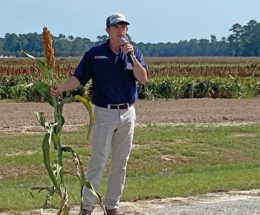
Other information provided during the field day included a presentation by Joe Roberts, Clemson turfgrass pathologist, who discussed root-dwelling pathogens that attack turfgrasses grown in South Carolina. These include fungi that cause diseases such as mini-ring. Roberts and other researchers also are looking at nematodes that feed on turfgrass roots throughout the year and how these nematodes may be interacting with fungal pathogens.
Rick Boyles, Clemson plant breeder and geneticist, talked about how dedicated breeding practices can help raise dryland grain sorghum yield limits.
Ben Powell, Clemson apiculturist and Pollinator Program coordinator, talked about strategies to use for pollinator habitats. Buckwheat is the easiest crop to plant to provide pollinator support as it “provides ample food for a whole lot of pollinators, as well as honeybees,” Powell said.
Bruce McLean, Clemson Extension area commercial horticulture agent, is looking at alternative soil amendments that offer comparable results to pine bark in blueberries. McLean also is working with Jenna Hershberger, vegetable breeding and genetics, on vegetable and butterbean breeding projects. One of their studies involves continuing Tony Melton’s research to develop a butterbean variety that can flourish in the South Carolina heat. Melton, who worked for Clemson 40 years, died on April 2, 2022.
Sandy soils are the most common types of soils found in South Carolina and Clemson graduate student Zhine Wang is working with Charles Williamson to diversify cover crop residues to improve organic production in sandy soils.
For information on these and other studies conducted at the Clemson Pee Dee REC, go to https://www.clemson.edu/cafls/research/peedee/.
-END-
Get in touch and we will connect you with the author or another expert.
Or email us at news@clemson.edu
